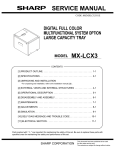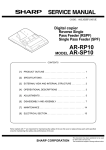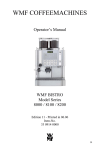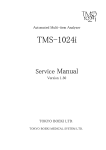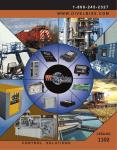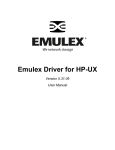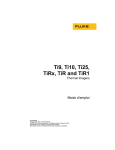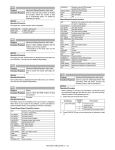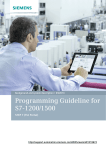Download Sharp MX-LCX2 Service manual
Transcript
SERVICE MANUAL
CODE: 00ZMXLCX2/S1E
DIGITAL FULL COLOR
MULTIFUNCTIONAL SYSTEM OPTION
LARGE CAPACITY TRAY
MODEL
MX-LCX2
CONTENTS
[1] PRODUCT OUTLINE. . . . . . . . . . . . . . . . . . . . . . . . . . . . . . . . . . . . . . . . 1-1
[2] SPECIFICATIONS . . . . . . . . . . . . . . . . . . . . . . . . . . . . . . . . . . . . . . . . . . 2-1
[3] UNPACKING AND INSTALLATION
* For unpacking and installation, refer to the installation manual( [2] ).
[4] EXTERNAL VIEWS AND INTERNAL STRUCTURES . . . . . . . . . . . . . . 4-1
[5] OPERATIONAL DESCRIPTION . . . . . . . . . . . . . . . . . . . . . . . . . . . . . . . 5-1
[6] DISASSEMBLY AND ASSEMBLY . . . . . . . . . . . . . . . . . . . . . . . . . . . . . . 6-1
[7] MAINTENANCE. . . . . . . . . . . . . . . . . . . . . . . . . . . . . . . . . . . . . . . . . . . . 7-1
[8] ADJUSTMENTS . . . . . . . . . . . . . . . . . . . . . . . . . . . . . . . . . . . . . . . . . . . 8-1
[9] SIMULATION . . . . . . . . . . . . . . . . . . . . . . . . . . . . . . . . . . . . . . . . . . . . . . 9-1
[10] SELF DIAG MESSAGE AND TROUBLE CODE . . . . . . . . . . . . . . . . . 10-1
[11] ELECTRICAL SECTION . . . . . . . . . . . . . . . . . . . . . . . . . . . . . . . . . . . 11-1
Parts marked with " " are important for maintaining the safety of the set. Be sure to replace these parts with
specified ones for maintaining the safety and performance of the set.
SHARP CORPORATION
This document has been published to be used
for after sales service only.
The contents are subject to change without notice.
CONTENTS
[1] PRODUCT OUTLINE . . . . . . . . . . . . . . . . . . . . . . . . 1-1
[2] SPECIFICATIONS . . . . . . . . . . . . . . . . . . . . . . . . . . 2-1
[3] UNPACKING AND INSTALLATION
* For unpacking and installation, refer to the installation
manual( [2] ).
[4] EXTERNAL VIEWS AND INTERNAL STRUCTURES
1. Motor, clutch, solenoid . . . . . . . . . . . . . . . . . . . . 4-1
2. PWB, sensor, switch, heater . . . . . . . . . . . . . . . . 4-2
[5] OPERATIONAL DESCRIPTION
1. Lift operation . . . . . . . . . . . . . . . . . . . . . . . . . . . . 5-1
2. Paper feed operation. . . . . . . . . . . . . . . . . . . . . . 5-1
3. Paper empty detection . . . . . . . . . . . . . . . . . . . . 5-2
[6] DISASSEMBLY AND ASSEMBLY
1. Maintenance parts replacement procedures . . . . . 6-1
2. Each unit removal . . . . . . . . . . . . . . . . . . . . . . . . 6-1
3. Major parts removal . . . . . . . . . . . . . . . . . . . . . . 6-2
[7] MAINTENANCE
1. Maintenance system table . . . . . . . . . . . . . . . . . 7-1
[8] ADJUSTMENTS
1. List . . . . . . . . . . . . . . . . . . . . . . . . . . . . . . . . . . . 8-1
2. Details . . . . . . . . . . . . . . . . . . . . . . . . . . . . . . . . . 8-1
[9] SIMULATION
1. List . . . . . . . . . . . . . . . . . . . . . . . . . . . . . . . . . . . 9-1
2. Details of trouble code . . . . . . . . . . . . . . . . . . . . 9-1
[10] SELF DIAG MESSAGE AND TROUBLE CODE
1. Self diag . . . . . . . . . . . . . . . . . . . . . . . . . . . . . . 10-1
2. Trouble code list . . . . . . . . . . . . . . . . . . . . . . . . 10-2
3. Trouble code details . . . . . . . . . . . . . . . . . . . . . 10-2
[11] ELECTRICAL SECTION
1. Electronic/mechanical parts relationship diagram . . . . 11-1
2. Block diagram . . . . . . . . . . . . . . . . . . . . . . . . . . 11-2
3. Wiring diagram . . . . . . . . . . . . . . . . . . . . . . . . . 11-3
MX-LCX2
[1]
PRODUCT OUTLINE
Service Manual
This model is a large capacity paper feed tray installed to the main unit.
It stores 3,500 sheets, eliminating troublesome paper supply.
MX-LCX2
MX-LCX2 PRODUCT OUTLINE 1 – 1
MX-LCX2
[2]
SPECIFICATIONS
Service Manual
Model
Transport reference
Large capacity tray
Center reference
Domestic: Heater kit support
Overseas: Service parts support
Heat reserving heater
Domestic
Paper capacity
Overseas
Normal paper
(64g/m2 ,17 lbs bond)
Normal paper
(80g/m2 ,21 lbs bond)
4000 sheets
3500 sheets
Paper size/type/weight
Paper size detection
Paper type setting
Paper size change system
Factory setting of paper size
Changeover by user
Changeover by service man
(Adjustment of guide and entry of size)
Domestic
Overseas, Inch series
Overseas, AB series
Remaining paper detection
Up
Down
Tray lift time
Troubleshooting of paper jam
Reliability
Life
Power source
Power consumption
Dimensions(WxDxH)
Occupying area(WxD)
Weight
Installation/Maintenance
Maintenance parts
Optional detection
Bundled item
Table 1 : Paper size, type, weight
Paper size
Thin paper
Normal paper
Kind/weight of
applicable
paper
Cardboard 1
(including gloss paper)
Cardboard 2
Envelope
A3W
A3
B4
A4
A4R
B5
B5R
A5R
12
11×17
8.5×14
8.5×13
8.5×11
8.5×11R
7.25×10.5R
5.5×8.5R
8K
16K
16KR
Postcard
Envelope
Special
55-59g/m2
15-16- lbs bond
60-105g/m2
16-28 lbs bond
106-209g/m2
28+-56- lbs bond
210-256g/m2
56-68 lbs bond
75-90g/m2
20-24 lbs bond
No
No
No
Yes
No
Yes*1
No
No
No
No
No
No
Yes
No
No
No
No
No
No
No
No
No
Refer to Table 1
Not provided (Manually setting from the control panel of the main unit)
Refer to Table 2
No
Yes
A4
8.5x11
A4
Paper empty and 6 steps
(100% ,83.3% ,66.7% ,50% ,33.3% ,16.7% ,Paper empty)
max. 15 sec.
max. 5sec.
Can be corrected without separating the unit.
MCBJ:Conforms to the main unit
MCBF:Conforms to the main unit
Conforms to the main unit
Supplied from the main unit
Normal operation: 26.4W
Lift up:40.8W
370 x 550 x 525mm
14 9/16x21 41/64x20 21/32 inch
370x550mm
14 9/16x21 21/32 inch
Approx. 28kg, 61.7lbs
Implemented by service man
Paper feed roller
Automatic detection
Parts for installation
Table2 : Paper type setting
Normal paper
Printed paper
Recycled paper
Letter head
Perforated paper
Color paper
Cardboard 1
Paper type
Cardboard 2
Thin paper
Label paper
OHP
Tab paper
Envelope
Use type 1 to 7
No
Yes
Yes
No
No
OHP paper
No
Label paper
No
Tab paper
No
*1)Setting of paper in B5 size is enabled in only Japan and overseas AB
series size paper is available.
MX-LCX2 SPECIFICATIONS 2 – 1
Yes
Yes
Yes
Yes
Yes
Yes
Yes
No
No
No
No
No
No
Yes
MX-LCX2
Manual
[4]
EXTERNAL VIEWS AND INTERNAL Service
STRUCTURES
1. Motor, clutch, solenoid
4
3
5
No.
1
2
Parts
Code
Signal name
Name
Type
Function/Operation
Drives the paper feed, and the
paper transport section.
1
LPFM
LPFM
Transport motor
Brushless motor
2
LLM
LLM
Lift motor
Brush motor
3
LTRC
LTRC
Transport clutch
Controls ON/OFF of the
transport roller.
Lifts the paper feed table.
4
LPFC
LPFC
Paper feed clutch
Controls ON/OFF of the paper
feed roller.
5
LPFS
LPFS
Paper feed
solenoid
Presses the paper pickup
roller onto paper.
Active condition
When paper feed is started,
"H" level.
When the lower limit sensor is
ON, "H" level. When the upper
limit sensor is ON, "L" level.
When paper feed is started,
"H" level. After starring
transport (pickup OFF), it is
turned OFF by the timer.
Turned OFF after starting
transport. Turned ON by the
timer.
* Lift-up - When paper empty
detection is made: ON
MX-LCX2 EXTERNAL VIEWS AND INTERNAL STRUCTURES 4 – 1
MODEL
NOTE
2. PWB, sensor, switch, heater
14
13
12
15
11
16
7
17
9
10
8
Parts
No.
Code
Signal name
-
Name
LCC main
PWB
Lower limit
sensor
Lift motor
encoder
Cassette
detection
The main unit
connection
sensor
Transport
sensor
Upper limit
sensor
7
MAIN PWB
8
LDD
LDD
9
LRE
LRE
10
LCSW
LCSW
11
LTOD
LTOD
12
LPFD
LPFD
13
LUD
LUD
14
LPED
LPED
Paper
presence/
empty sensor
15
LLSW
LLSW
Upper limit
switch
16
LDSW
LDSW
17
DH
DH
Upper open/
close switch
Thermal
heater
Type
Function/Operation
Active condition
MODEL
Controls and drives the LCC.
The lower limit of the tray is
detected.
The lift motor rotation is
detected.
When the tray is at the lower
limit, "H" level.
The tray insertion is detected.
When inserted, "H" level.
Detects connection to the main
unit.
When connected, "L" level.
Detects paper transport.
Detects the paper upper limit
position.
Detects paper presence/empty
on the paper tray.
Pulse signal
L level at paper remaining
detection.
When "H" level (ON), the lift-up
motor stops.
When paper is detected, "L".
* When lifting up, if "L" with
LRE 800 pulse, the paper
feed solenoid is ON.
Protects the paper feed unit
from breakage due to lifting the
tray too much.
Detects open/close of the upper
door.
Keeps temperature in the LCC
tray.
MX-LCX2 EXTERNAL VIEWS AND INTERNAL STRUCTURES 4 – 2
Japan
only
NOTE
[5] OPERATIONAL DESCRIPTION
MX-LCX2
Service Manual
1. Lift operation
When the main unit is turned ON, if the tray is at the lower limit
position (lower limit sensor: LDD ON position), the lift motor is
turned ON to lift the tray.
When the paper presence/empty sensor (LPED) is turned ON
within 800 pulses of the encoder signal from start of lifting up the
tray, the lift motor is turned OFF to stop the tray, and the paper feed
solenoid is turned ON to move down the pickup roller. After that,
the lift motor is turned ON to lift the tray. The tray is stopped when
the upper limit sensor (LUD) is turned ON.
Lifting up operation (When LPED is turned ON within 800 pulses of encoder.)
When the tray is pulled out, it moves down by its own weight.
LLM
(Lift motor output)
LLD
(Lower limit sensor)
LUD
(Upper limit sensor)
LUD
(Upper limit sensor)
LPED
(Paper empty detection)
LPED
(Paper empty detection)
LPFS
(Solenoid)
When the machine power is turned on, if the tray is on the paper
feed position, lifting is not performed.
Lifting up operation (When LPED is not turned ON within 800 pulses of encoder.)
200 msec
LLM
(Lift motor output)
LLD
(Lower limit sensor)
If the paper presence/empty sensor (LPED) is not turned on within
800 pulses, the paper feed solenoid is turned ON with the lift motor
ON to move down the pickup roller. The lift motor is stopped at the
upper limit sensor (LUD) ON position, and the paper feed solenoid
is turned OFF.
LPFS
(Solenoid)
Within 800 pulses
Within 800 pulses
LRE
(Encoder signal)
LRE
(Encoder signal)
2. Paper feed operation
When the tray is stationary at the paper feed position (upper limit
sensor: LUD ON position) and there is paper on the tray, paper
feed operation can be performed.
Paper feed operation is performed by the transport motor (LPFM),
the transport clutch (LTRC), the paper feed clutch (LPFC), and the
paper feed solenoid (LPFS) at the following timing.
When the transport clutch (LTRC) is turned ON with the transport
motor (LRFM) ON (rotating), the transport roller rotates. When the
paper feed clutch (LPFC) is turned on under this state, the paper
feed roller and the take-up roller rotate. When the paper feed solenoid (LPFS) is turned ON, the take-up roller is pushed down to
press paper.
LCC paper feed time chart
Paper feed start
Clearance-betweenpapers control timer
Resist stop
Resist stop
Resist stop
Clearance-betweenpapers control timer
Clearance-betweenpapers control timer
Clearance-betweenpapers control timer
Resist stop
LPFM
(Transport motor)
LPFD
(Transport sensor)
LPFS
(Paper feed solenoid)
LPFC
(Paper feed clutch)
PIC drop timer
PIC drop timer
PIC drop timer
PIC drop timer
Paper feed clutch
OFF timer
Paper feed clutch
OFF timer
Paper feed clutch
OFF timer
Paper feed clutch
OFF timer
Paper feed clutch
OFF timer
LTRC
(Transport clutch)
TRC
(Main unit
synchronous signal)
Preliminary
paper feed start
First sheet
Preliminary paper
feed complete
Paper feed start
Preliminary
paper feed start
Second sheet
Preliminary paper
feed complete
Paper feed start
Preliminary
paper feed start
Third sheet
Preliminary paper
feed complete
Paper feed start
Preliminary
paper feed start
Fourth sheet
Preliminary paper
feed complete
MX-LCX2 OPERATIONAL DESCRIPTION 5 – 1
Preliminary
paper feed start
Fifth sheet
Preliminary paper
feed complete
5
1
4
6
3
7
2
1
2
3
4
5
6
7
Paper feed roller clutch
Take-up roller
Paper feed roller
Paper feed solenoid
Transport clutch
Transport motor
Lift-up motor
3. Paper empty detection
When the tray lifts and stops at the paper feed position and during
paper feed operation, paper presence/empty is detected by the
paper presence/empty sensor (LPED).
When paper empty is detected in the tray during paper feeding,
paper feeding is stopped.
MX-LCX2 OPERATIONAL DESCRIPTION 5 – 2
MX-LCX2
[6]
DISASSEMBLY AND
ASSEMBLY
2.
EachManual
unit removal
Service
A. Paper feed unit
1)
Pull out the tray.
2)
Open the upper cover, and remove three screws.
3)
Remove the upper cabinet.
4)
Disconnect the connectors (2 positions).
5)
Remove the screw, and remove the paper feed unit.
1. Maintenance parts replacement
procedures
A. Paper feed roller
1)
Pull the lever, and open the upper cover.
2)
Remove the screw, and remove the sheet.
3)
Remove the pawl, and remove the take-up roller and the paper
feed roller.
4)
Remove the screw, and remove the paper guide block.
5)
Remove the pawl, and remove the reverse roller.
MX-LCX2 DISASSEMBLY AND ASSEMBLY 6 – 1
B. Paper feed tray
C. Drive unit
1)
Pull out the tray.
1)
Remove the screw, and remove the rear cover.
2)
Looser the stopper fixing screw (1) on the lower right side of
the paper tray, evacuate the stopper not to function.
2)
Remove the connectors (2 positions).
3)
Remove the screw, and remove the drive unit.
3)
4)
Remove the screws from the left and right rail sections.
Remove the tray unit from the rail.
3. Major parts removal
A. Motor (Main)
1)
Remove the screw, and remove the rear cover.
2)
Disconnect the connector.
3)
Remove the screw, and remove the motor.
MX-LCX2 DISASSEMBLY AND ASSEMBLY 6 – 2
B. Lift motor
C. Clutch
1)
Remove the drive unit.
1)
Remove the paper feed unit. (Refer to "3. Each unit removal.")
2)
Remove the E-ring, and remove the parts.
2)
Remove the screw, and remove the cover.
3)
Remove the screw, and remove the cover.
3)
Remove the E-ring, and remove the parts.
4)
Disconnect the connector, and remove the screw.
5)
Remove the frame.
4)
5)
Remove the screw, and remove the lift motor.
Remove the ring, and remove the pulley.
MX-LCX2 DISASSEMBLY AND ASSEMBLY 6 – 3
6)
Remove the connector, and the E-ring, and remove the paper
feed, transport clutch, respectively.
E. Torque limiter
1)
Remove the paper feed unit.
2)
Remove the cover.
3)
Remove the E-ring and the screw, and remove the parts.
4)
Lift the shaft, and remove the torque limiter.
D. Paper feed solenoid
1)
Remove the paper feed unit.
2)
Remove the cover.
3)
Remove the screw, and remove the unit.
4)
Disconnect the connector.
5)
Remove the screw, and remove the solenoid.
MX-LCX2 DISASSEMBLY AND ASSEMBLY 6 – 4
F. Transport roller
1)
Remove the paper feed unit.
2)
Remove the cover.
3)
Remove the spring, and remove the screw.
4)
Remove the plate cover, and remove the lever.
5)
Remove the clutch.
6)
Remove the screw and the E-ring, and remove the parts.
7)
Remove the transport roller.
MX-LCX2 DISASSEMBLY AND ASSEMBLY 6 – 5
[7] MAINTENANCE
MX-LCX2
Service Manual
1. Maintenance system table
✕ : Checking (clean, replace or adjust as required)
No.
Part name
When
calling
{ : Cleaning
∆ : Adjust
Main unit
maintenance cycle
1
Pick-up roller/each paper feed roller
✕
{
2
Torque limiter
✕
✕
3
4
5
6
7
Each transport rollers
Each transport paper guides
Each gears
Each belts
Each sensors
✕
{
✕
{
{
✕
✕
✕
✕
▲ : Replace
✩ : Lubricate
: Position shift
Remarks
As a rough guide, these rollers should be replaced when the LCC paper feed
counter reaches a value of 100K (Sim22-9) or when one year has elapsed
since the start of use.
As a rough guide, the torque limiter should be replaced when the LCC paper
feed counter reaches a value of 800K (Sim22-9).
MX-LCX2 MAINTENANCE 7 – 1
MX-LCX2
[8]
ADJUSTMENTS
Service Manual
Each adjustment item in the adjustment item list is indicated with its JOB number. Perform the adjustment procedures in the sequence of Job
numbers from the smallest to the greatest.
However, there is no need to perform all the adjustment items. Perform only the necessary adjustments according to the need.
Unnecessary adjustments can be omitted. Even in this case, however, the sequence from the smallest to the greatest JOB number must be
observed.
If the above precaution should be neglected, the adjustment would not complete normally or a trouble may occur.
1. List
Job No.
ADJ 1
ADJ 2
Adjustment item list
Print off-center adjustment
Resist amount adjustment
ADJ 2A
ADJ 2B
Change in the resist amount adjustment/deflection amount correction value
Adjustment of the print lead edge adjustment
Simulation to
be used
50-10
51-02
50-05
2. Details
ADJ 1 Print off-center adjustment
1)
Execute SIM.50-10 by the key operation of the machine. Then,
the displays shown on the right side appear.
2)
The print off-center adjustment value can be set for each tray.
3)
Press the [↓] key on the touch panel to select “G:50:LCC”.
4)
Then, enter your desired adjustment value with the [10] key.
(Default: 50
[Switching of screen]
0
TEST
PAPER CENTER OFFSET SETUP
G:
50
㨇
㨉
Adjustment range: from 1 to 99)
* If the adjustment value is decreased by 1, the main scanning
print position is shifted to the front side by 0.1mm.
* If the adjustment value is increased by 1, the main scanning
print position is shifted to the rear side by 0.1mm.
5)
6)
CLOSE
SIMULATION NO50-10
When the [EXECUTE] button is pressed, the [EXECUTE] button is highlighted, currently set value is saved into the
EEPROM and the RAM, and printing for adjustment pattern
image is started. After printing is finished, the [EXECUTE] button returns to the normal display status.
A㧦100
㧧
B㧦 50
㧧 MFT
BK-MAG
C㧦 50
㧧 CS1
D㧦 50
㧧 CS2
E㧦 50
㧧 CS3
F㧦 50
㧧 CS4
G㧦 50
㧧 LCC
H㧦 50
㧧 ADU
I㧦
1
㧧 MULTICOUNT
J㧦
2
㧧 PAPER㧦CS1
K㧦 1
㧧 DUPLEX㧦NO
OK
EXECUTE
Check the adjustment pattern image position.
Measure the dimensions of the void area in the adjustment
pattern front and rear frame directions, and ensure that they
satisfy the conditions shown below.
10
Key
EXECUTE
EXECUTE
Printing is finished
A
0
TEST
CLOSE
SIMULATION NO50-10
PAPER CENTER OFFSET SETUP
+ 3.0mm
A-B = 0 -
G:
60
㨇
B
If condition of A - B = 0±3.0mm is satisfied, no adjustment is
necessary.
If it does not satisfy the condition above, execute the procedures shown below.
7)
Change the adjustment value. Repeat the steps from 4) to 6)
until the condition described in the step 6) is satisfied.
8)
After the adjustment is finished, escape from the simulation
mode with the reset key.
MX-LCX2 ADJUSTMENTS 8 – 1
㨉
A㧦 100
㧧 BK-MAG
B㧦 50
㧧 MFT
C㧦 50
㧧 CS1
D㧦 50
㧧 CS2
E㧦 50
㧧 CS3
F㧦 50
㧧 CS4
G㧦 50
㧧 LCC
H㧦 50
㧧 ADU
I㧦
1
㧧 MULTICOUNT
J㧦
2
㧧 PAPER㧦CS1
K㧦 1
㧧 DUPLEX㧦NO
EXECUTE
OK
<<Description of items>>
Item
A
B
Display item and details
BK-MAG
MFT
C
D
E
F
G
H
I
J
CS1
CS2
CS3
CS4
LCC
ADU
MULTI COUNT
PAPER
K
DUPLEX
MFT
CS1
CS2
CS3
CS4
LCC
YES
NO
Descriptions
Main scanning print magnification BK
Print off-center adjustment value (manual)
Print off-center adjustment value
(cassette 1)
Print off-center adjustment value (cassette 2)
Print off-center adjustment value (cassette 3)
Print off-center adjustment value (cassette 4)
Print off-center adjustment value (LCC)
Print off-center adjustment value (ADU)
Number of printed sheets
Cassette selection
Manual
Cassette 1
Cassette 2
Cassette 3
Cassette 4
LCC
Double sided print selection
Select
Not select
ADJ 2 Resist amount adjustment
2-A Changing resist amount adjustment/
deflection amount correction value
1)
Execute SIM.51-2 by the key operation of the machine. Then,
the displays shown on the right side appear.
Setting range
60 to 140
1 to 99
Default
100
50
Writing
Yes
Yes
1 to 99
1 to 99
1 to 99
1 to 99
1 to 99
1 to 99
1 to 999
50
50
50
50
50
50
1
2
(CS1)
Yes
Yes
Yes
Yes
Yes
Yes
No
No
1(NO)
No
1 to 6
1
2
3
4
5
6
0
1
0 to 1
[Switching of screen]
0
TEST
CLOSE
SIMULATION NO51-02
REGIST ROLLER ADJUSTMENT
U:
50
N: 50
;
MANUAL HEAVY PAPER1(L)
O: 50
;
MANUAL OHP1
P: 50
;
MANUAL ENV
ADU PLAIN PAPER(S)
2)
Select the [ENGIN] button.
3)
Press the [↓] key on the touch panel to select “U:50:A4LCC”.
Q: 50
;
4)
Then, enter your desired adjustment value with the [10] key.
R: 50
;
ADU PLAIN PAPER(L)
(Default: 50
S:
50
;
ADU HEAVY PAPER1(S)
T: 50
;
ADU HEAVY PAPER1(L)
U: 50
;
A4LCC
V: 50
;
A3LCC(S)
(If the adjustment value is changed by “1”, the stop timing is
changed by 0.1mm (1.0msec).)
W: 50
;
A3LCC(L)
After the adjustment value is entered, press the [OK] key on
the touch panel to save the set value.
X: 50
;
A3LCC HEAVY PAPER‚P(S)
Y: 50
;
㨇
㨉
Ajustment range: from 1 to 99)
* As the adjustment value is increased, the deflection amount
is also increased. As the adjustment value is decreased, the
deflection amount is also decreased.
5)
6)
After the adjustment is finished, escape from the simulation
mode with the reset key.
REGI2
REGI1
A3LCC HEAVY PAPER‚P(L)
ENGIN
㪈㪇
OK
Key
OK
0
TEST
CLOSE
SIMULATION NO51-02
REGIST ROLLER ADJUSTMENT
U:
60
㨇
REGI1
MX-LCX2 ADJUSTMENTS 8 – 2
㨉
REGI2
N: 50
;
MANUAL HEAVY PAPER1(L)
O: 50
;
MANUAL OHP1
P: 50
;
MANUAL ENV
Q: 50
;
ADU PLAIN PAPER(S)
R: 50
;
ADU PLAIN PAPER(L)
S:
;
ADU HEAVY PAPER1(S)
50
T: 50
;
ADU HEAVY PAPER1(L)
U: 60
;
A4LCC
V: 50
;
A3LCC(S)
W: 50
;
A3LCC(L)
X: 50
;
A3LCC HEAVY PAPER‚P(S)
Y: 50
;
A3LCC HEAVY PAPER‚P(L)
ENGIN
OK
<<Setting range and defaults of set values>>
Item
Button
A
B
C
D
E
F
G
H
I
J
K
L
M
N
O
P
Q
R
S
T
U
V
W
X
Y
ENGIN
Item to be displayed
TRAY1(S)
TRAY2(S)
TRAY3 PLAIN PAPER
(S)
TRAY3 PLAIN PAPER
(L)
TRAY3 HEAVY
PAPER1 (S)
TRAY3 HEAVY
PAPER1 (L)
TRAY4 PLAIN PAPER
(S)
TRAY4 PLAIN PAPER
(L)
TRAY4 HEAVY
PAPER1 (S)
TRAY4 HEAVY
PAPER1 (L)
MANUAL PLAIN
PAPER (S)
MANUAL PLAIN
PAPER (L)
MANUAL HEAVY
PAPER1 (S)
MANUAL HEAVY
PAPER1 (L)
MANUAL OHP1
MANUAL ENV
ADU PLAIN PAPER (S)
ADU PLAIN PAPER (L)
ADU HEAVY PAPER1
(S)
ADU HEAVY PAPER1
(L)
A4LCC
A3LCC (S)
A3LCC (L)
A3LCC HEAVY
PAPER1 (S)
A3LCC HEAVY
PAPER1 (L)
Host machine tray 1, deflection adjustment value (small size)
Host machine tray 2, deflection adjustment value (small size)
Host machine tray 3, deflection adjustment value
(normal paper, small size)
Host machine tray 3, deflection adjustment value
(normal paper, large size)
Host machine tray 3, deflection adjustment value
(Cardboard 1, small size)
Host machine tray 3, deflection adjustment value
(Cardboard 1, large size)
Host machine tray 4, deflection adjustment value
(Normal paper, small size)
Host machine tray 4, deflection adjustment value
(Normal paper, large size)
Host machine tray 4, deflection adjustment value
(Cardboard 1, small size)
Host machine tray 4, deflection adjustment value
(Cardboard 1, large size)
Not more than LT size
Not more than LT size
Setup
range
1 to 99
1 to 99
Not more than LT size
1 to 99
50
Not less than LT size
1 to 99
50
Not more than LT size
1 to 99
50
Not less than LT size
1 to 99
50
Not more than LT size
1 to 99
50
Not less than LT size
1 to 99
50
Not more than LT size
1 to 99
50
Not less than LT size
1 to 99
50
Manual tray, deflection adjustment value (Normal paper, small size)
Not more than LT size
1 to 99
50
Manual tray, deflection adjustment value (Normal paper, large size)
Not less than LT size
1 to 99
50
Manual tray, deflection adjustment value (Cardboard1, small size)
Not more than LT size
1 to 99
50
Manual tray, deflection adjustment value (Cardboard1, large size)
Not less than LT size
1 to 99
50
Manual tray, deflection adjustment value (OHP1)
Manual tray, deflection adjustment value (Envelope)
ADU, deflection adjustment value (normal paper, small size)
ADU, deflection adjustment value (normal paper, large size)
Not more than LT size
Not less than LT size
1 to 99
1 to 99
1 to 99
1 to 99
50
50
50
50
ADU, deflection adjustment value (Cardboard1, small size)
Not more than LT size
1 to 99
50
ADU, deflection adjustment value (Cardboard1, large size)
Descriptions (Mode, original, paper feeed speed)
Feed direction
Default
50
50
Not less than LT size
1 to 99
50
A4LCC, deflection adjustment value
A3LCC deflection adjustment value (Normal paper, small size)
A3LCC deflection adjustment value (Normal paper, large size)
Not more than LT size
Not less than LT size
1 to 99
1 to 99
1 to 99
50
50
50
A3LCC deflection adjustment value (Cardboard, small size)
Not more than LT size
1 to 99
50
A3LCC deflection adjustment value (Cardboard, large size)
Not more than LT size
1 to 99
50
MX-LCX2 ADJUSTMENTS 8 – 3
2-B Print lead edge adjustment
1)
Execute SIM.50-5 by the key operation of the machine. Then,
the displays shown on the right side appear.
2)
Press the [↓] key on the touch panel to select “E:PAPER”.
3)
Then, enter the adjustment value 6 with the [10] key, and press
the [OK] button.
(Adjustment value 6: LCC)
4)
5)
When the [EXECUTE] button is pressed, the [EXECUTE] button is highlighted, and printing for adjustment pattern image is
started with the currently set value. After printing is finished,
the [EXECUTE] button returns to the normal display status.
[Switching of screen]
0
TEST
CLOSE
SIMULATION NO50-05
LEAD EDGE ADJUSTMENT VALUE(PRINTER)
A:
[
30
1 㨪 99
A㧦 30
㧧
B㧦 20
㧧 DEN-B
C㧦 20
㧧 FRONT/REAR
]
DEN-C
D㧦 1
㧧 MULTI COUNT
E㧦 2
㧧
PAPER : CS1
F㧦 1
㧧
DUPLEX : NO
Check the adjustment pattern image position.
Measure the dimensions of the void area in the adjustment
pattern right and left frame directions, and ensure that they satisfy the conditions shown below.
A
EXECUTE
OK
EXECUTE
+ 2.0mm
A = 4.0 + 2.0mm
B = 4.0 -
EXECUTE
Printing is finished
0
B
TEST
If condition of A=4.0±2.0mm, B=4.0±2.0mm is satisfied, no
adjustment is necessary.
If it does not satisfy the condition above, execute the procedures shown below.
6)
CLOSE
SIMULATION NO50-05
LEAD EDGE ADJUSTMENT VALUE(PRINTER)
A:
㨇 1㨪
40
99 㨉
Change the adjustment values of the adjustment items
A(DEN-C) and B(DEN-B).
A㧦 40
㧧
B㧦 20
㧧 DEN-B
C㧦 20
㧧 FRONT/REAR
DEN-C
D㧦 1
㧧 MULTI COUNT
E㧦 2
㧧
PAPER : CS1
F㧦 1
㧧
DUPLEX : NO
* As the adjustment value of the item A(DEN-C) is decreased
by 1, the print start position is moved to the lead edge side of
paper against the paper feed direction by 0.1mm.
* As the adjustment value of the item B(DEN-B) is decreased
by 1, the print range is increased to the trailing edge side of
paper against the paper feed direction by 0.1mm.
7)
Repeat the steps from 4) to 6) until the condition shown in the
step 5) is satisfied.
8)
After the adjustment is finished, escape from the simulation
mode with the reset key.
MX-LCX2 ADJUSTMENTS 8 – 4
EXECUTE
OK
<Description of items>
Item
Display items and
details
Descriptions
Setup range
Default
Writing
A
DEN-C
Print lead edge adjustment
1 to 99
30
Yes
B
DEN-B
Sub scanning direction print area
adjustment
1 to 99
20
Yes
C
FRONT/REAR
FRONT/REAR void amount
adjustment
1 to 99
20
Yes
D
MULTI COUNT
Number of printed sheets
1 to 999
1
No
2
(CS1)
No
1
(NO)
No
E
PAPER
F
DUPLEX
MFT
CS1
CS2
CS3
CS4
LCC
YES
NO
Cassette selection
Double-sided print
selection
Manual 1
Cassette 1
Cassette 2
Cassette 3
Cassette 4
LCC
Selected
Not selected
1 to 6
0 to 1
1
2
3
4
5
6
0
1
* The item name for the items J and K is detailed display.
Example: PAPER: CS1
MX-LCX2 ADJUSTMENTS 8 – 5
Remarks
Adjustment value for matching to the print lead
edge for printer.
As the adjustment value of this item is decreased
by 1, the print start position against the paper
feeding direction is moved to the leading edge side
by 0.1mm.
Amount of void to be created at the trailing edge of
paper. As the adjustment value of the item B(DENB) is decreased by 1, the sub scanning print range
adjustment value is decreased by 0.1mm.
Amount of void to be created at the right and left
edges of paper. As the value is increased, the void
amount is increased.
MX-LCX2
[9]
SIMULATION
Service Manual
1. List
Code
Main
Function (purpose)
Sub
2
4
3
15
Purpose
Used to check the operations of the sensors and detectors in the large capacity tray
(LCC) and the control circuit.
Used to check the operations of the loads in the large capacity tray (LCC) and the
control circuit.
Operation test/Check
Operation test/Check
5
Used to check the operations of the clutch (LTRC) in the LCC and the monitor.
Operation test/Check
-
Used to cancel the self-diag "U6-09 (large capacity paper feed tray)" trouble.
Clear/cancel (Trouble
etc.)
2. Details of trouble code
Section
Large capacity tray
(LCC)
Large capacity tray
(LCC)
Large capacity tray
(LCC)
LCC
4-3
Operation test/Check
Purpose
4
Function (Purpose) Used to check the operations of the loads
in the large capacity tray (LCC) and the
control circuit.
4-2
Function (Purpose) Used to check the operations of the sensors and detectors in the large capacity tray
(LCC) and the control circuit.
The operating conditions of the sensors and detectors are displayed.
Sensors and detectors which are turned on are highlighted.
TEST
LCC transport sensor
LCC tray upper limit detection
LCC tray lower limit detection
LCC tray paper empty detection
LCC tray insertion detection
LCC upper open/close detection SW
LCC lift motor encoder detection
LCC 24V power monitor
LCC upper limit SW
LCC main unit connection detection
2) Press [EXECUTE] key.
<MX-LCX2>
LPFM
LLM
LPFC
LPFS
LTRC
TEST
LCC transport motor
LCC lift motor
LCC paper feed clutch
LCC paper feed solenoid
LCC transport clutch
CLOSE
SIMULATION NO.04-03
LCC LOAD CHECK
LPFM
LLM
LPFC
LPFS
LTRC
CLOSE
SIMULATION NO.04-02
LCC SENSOR CHECK
LPFD
1) Select a target of the operation check with the touch panel.
When [EXECUTE] is pressed, the operation is stopped.
Operation/Procedure
<MX-LCX2>
LPFD
LUD
LDD
LPED
LCD
LDSW
LRE
L24VM
LLSW
LTOD
Operation/Procedure
The selected load is operated.
Large capacity tray (LCC)
Section
Large capacity tray (LCC)
Section
Operation test/Check
Purpose
LUD
LDD
LPED
LCD
LDSW
LRE
L24VM
LLSW
LTOD
EXECUTE
1/1
MX-LCX2 SIMULATION 9 – 1
1/1
4-5
15
Operation test/Check
Purpose
Function (Purpose) Used to check the operations of the clutch
(LTRC) in the LCC and the monitor.
Large capacity tray (LCC)
Section
15-Clear/cancel (Trouble etc.)
Purpose
Function (Purpose) Used to cancel the self-diag "U6-09 F3-12,
F3-22(largecapacity paper feed tray, paper
feed tray 1, 2)" trouble.
Operation/Procedure
1) Press LTRC key to check the sync signal.
When normal: ON When abnormal: OFF
LCC
Section
2) Press the highlighted LTRC key to check the sync signal.
Operation/Procedure
When normal: OFF When abnormal: ON
1) Press [EXECUTE] key.
2) Press [YES] key to execute cancellation of the trouble.
TEST
SIMULATION NO.04-05
CLOSE
LCC SYNCRONIZING SIGNAL CHECK
LTRC
TEST
:
CLOSE
SIMULATION NO.15
LTRC OFF
LCC TROUBLE CANCELLATION
ARE YOU SURE?
1/1
MX-LCX2 SIMULATION 9 – 2
YES
NO
EXECUTE
[10] SELF DIAG MESSAGE AND
TROUBLE CODE
MX-LCX2
1. Self diag
Service Manual
Monitors the machine
conditions.
Detects/analyzes
the content.
A. General
When a trouble occurs in the machine or when the life of a consumable part is nearly expired or when the life is expired, the machine
detects and displays it on the display section or notifies to the user
or the serviceman by voice messages. This allows the user and the
serviceman to take the suitable action. In case of a trouble, this feature notifies the occurrence of a trouble and stops the machine to
minimize the damage.
Warning
Trouble/Warning
Trouble
The machine is stopped.
B. Function and purpose
1)
Securing safety. (The machine is stopped on detection of a
trouble.)
2)
The damage to the machine is minimized. (The machine is
stopped on detection of a trouble.)
3)
By displaying the trouble content, the trouble position can be
quickly identified. (This allows to perform an accurate repair,
improving the repair efficiency.)
4)
Preliminary warning of running out of consumable parts allows
to arrange for new parts in advance of running out. (This
avoids stopping of the machine due to running out the a consumable part.)
C. Self diag message kinds
• The self diag messages are classified as shown in the table
below.
Class 1
User
Class 2
Service
man
Other
Warning
Trouble
Other
Warning of troubles which can be recovered by the
user. (Paper jam, consumable part life expiration,
etc.)
Warning of troubles which can be recovered only by
a serviceman. (Motor trouble, maintenance, etc.)
Warning to the user, not a machine trouble
(Preliminary warning of life expiration of a
consumable part, etc.)
Warning of a machine trouble. The machine is
stopped.
-
The content is displayed.
Trouble/Warning
Warning
Trouble
Troubleshoot the cause.
Repair
Cancel the selfdiagnostic message with
the diagnostics
(test commands).
Reset
Standby state
D. Self diag operation
(1) Self diag operation and related work flow
The machine always monitors its own state.
When the machine recognizes a trouble, it stops the operation and
displays the trouble message.
A warning message is displayed when a consumable part life is
nearly expired or is expired.
When a warning message is displayed, the machine may be or
may not be stopped.
The trouble messages and the warning messages are displayed by
the LCD.
Some trouble messages are automatically cleared when the trouble is repaired. Some other troubles must be cleared by a simulation.
Some warning messages of consumable parts are automatically
cleared when the trouble is repaired. Some other warning messages must be cleared by a simulation.
MX-LCX2 SELF DIAG MESSAGE AND TROUBLE CODE 10 – 1
A consumable
part has reached
its lifetime.
YES
Replace or supply
the consumable part.
NO
2. Trouble code list
No.
1
2
3
4
5
MAIN
CODE
U6
SUB
CODE
09
20
21
22
51
Title (Content)
Lift motor trouble
Communication trouble
Transport motor trouble
24V trouble
LCC incompatibility trouble
Section
LCC
LCC
LCC
LCC
LCC
3. Trouble code details
U6-09
LCC lift motor trouble
Trouble content
Section
Case 1
Cause
Check
and
Remedy
• The encoder input value is not changed in
0.2sec (1st time)/0.5sec (2nd time and later)
after rotation of the motor.
• The motor is rotated for 24sec or more.
PCU
Sensor trouble, LCC control PWB trouble, gear
breakage, lift motor trouble
Use SIM4-2 and 4-3 to check the operation of the
sensor and the lift motor. Use SIM15 to cancel the
trouble.
Operation mode
Tray lift-up
LCC communication
Paper feed
Power ON
Power ON
U6-22
Check
and
Remedy
LCC communication trouble
Trouble content
Section
Case 1
Cause
Check
and
Remedy
U6-21
DC24V power is not supplied to LCC.
PCU
Connector and harness connection trouble or
disconnection, LCC control PWB trouble, power
unit trouble
Check the connector and the harness of the power
line. Check that the power unit and the LCC control
PWB is of 24V.
Cause
Check
and
Remedy
Detection of LCC connection which is incompatible
with the MX-5500N/6200N/7000N series.
PCU
Connection of the LCC, which is incompatible with
the MX-5500N/6200N/7000N series is detected.
Connect the MX-LCX2.
LCC transport motor trouble
Trouble content
Section
Case 1
LCC communication error. Communication line test
error after turning ON the power or canceling the
exclusive simulation. LCC and machine model
codes discrepancy error
PCU
Connector and harness connection trouble or
disconnection, LCC control PWB trouble, control
(PCU) PWB trouble, malfunction due to electrical
noises
Turn OFF/ON the power to cancel the trouble.
Check the connector and the harness of the
communication line.
Section
Case 1
Check connection.
Turn OFF/ON the power.
Check connection.
Check connection.
Check connection.
LCC incompatibility trouble
Trouble content
U6-20
Cause
Check
and
Remedy
Note
LCC 24V power abnormality
Trouble content
Section
Case 1
Cause
U6-51
Countermeasure (Remedy)
After passing 1 sec from turning ON the motor, the
lock state of the motor lock signal is detected
continuously for 1 sec.
PCU
Motor lock, motor RPM abnormality, an overcurrent
to the motor, LCC control PWB trouble
Use SIM4-3 to check the operation of the transport
motor.
MX-LCX2 SELF DIAG MESSAGE AND TROUBLE CODE 10 – 2
MX-LCX2
[11]
ELECTRICAL SECTION
Service Manual
1. Electronic/mechanical parts relationship diagram
CN-B
B8B-PH-K-S
1
+5V
+5V
2
3
LRE
4
LDD
5
GND2
6
GND2
7
+24V
(/LTLS)
8
CN-E
B14B-PHDSS-B
+5V
LCD
GND2
GND2
LLM
N.C.
LLM(GND)
N.C.
/LPFM-CLK
LPFM-T
/LPFM-EN
GND1
GND1
+24V(LOSW)
LCC MAIN PWB CR
SMR-03V-N
1
2
3
1
2
3
LRE
GND2
+5V
1
2
3
SMR-03V-N
1
2
3
1
2
3
LDD
GND2
+5V
ELR-03V
1
2
3
LCD
GND2
+5V
1
LLM(GND)
2
LLM
PHR-5
1 +24V
2 GND1
3 /LPFM-EN
4 LPFM-T
5 /LPFM-CLK
1
2
3
4
5
6
7
8
9
10
1
2
3
4
5
6
7
8
9
10
11
12
13
14
15
16
17
18
19
20
21
22
23
24
SMP-03V-NC
1
2
3
1
2
3
1
2
3
CN-D
B10B-PHDSS-B
+24V(LDSW)
+24V(LLSW)
GND2
GND2
+24V(LLSW)
GND2
GND2
+24V(L24VM)
GND2
+24V(L24VM)
CN-C
B24B-PHDSS-B
+24V
/LPFC
+24V
/LTRC
/LPFS
GND1
GND2
GND2
GND2
GND2
GND2
GND2
LUD
/LPED
/LPFD
/LTOD
EXIN1
EXIN2
+5V
+5V
+5V
+5V
+5V
+5VR
SMP-03V-NC
SMR-03V-N
1
2
3
ELP-03V
ELR-04NV
SMP-18V-NC
1
2
3
4
5
6
7
8
9
10
11
12
13
14
15
16
17
18
SMR-03V-N
1
2
3
SMP-03V-NC
1
2
3
1
2
3
4
5
6
7
8
9
10
11
12
13
14
SMP-03V-NC
1
2
3
1
2
3
4
SMR-18V-N
1
2
3
4
5
6
7
8
9
10
11
12
13
14
15
16
17
18
179228-3
1
+5V
2
/LTOD
3
GND2
PS-187-3V
1
COM
2
ON
3
NC
FPS-187
1
COM
2
ON
3
NC
ELP-04NV
1
2
3
4
PHR-3
1
2
3
PHR-3
1
2
3
SMP-03V-NC
1
2
3
SMP-02V-NC
1
2
SMR-03V-N
1
2
3
GND2
/LPED
+5V
GND2
LUD
+5V
SMR-03V-N
1
2
3
SMR-02V-N
1
2
SMP-03V-NC
1
2
3
PHR-3
1
2
3
+5VR
GND2
/LPFD
CZHR-03V-S
1
+24V
2
N.C.
3
/LTRC
LTRC
LPFC
LPFS
LTOD
LPFM
LPFD
LDSW
LLM
LLSW
LRE
LUD
LPED
LCD
LDD
MX-LCX2 ELECTRICAL SECTION 11 – 1
MX-2300/2700
F
AC-N
AC-L
+24V
GND1
GND2
+5V
/TRC-LCC
RES-LCC
/DTR-LCC
F
/DSR-LCC
/TXD-LCC
/RXD-LCC
MX-LCX2
Ground
Heater
+24V
+5V
Xtal
7.37MHz
MX-LCX2 ELECTRICAL SECTION 11 – 2
EEPROM
On-board write circuit
GND2
Input buffer
Input buffer
Input buffer
Output buffer
Input buffer
Output buffer
LCC MAIN PWB CR
CPU (H8/3687HV)
LLSW
-
LDSW
-
L24VM
(TD62003AP)
Transistor array
Sensor input
circuit
Upper limit
monitoring circuit
Upper door
monitoring circuit
Poly switch 1.1A
Current control
circuit
Lift motor drive circuit
24V monitoring circuit
+24V
/LPFM
/LPFM-CLK
LPFM-T
+24V
+24V
LPFS
+24V
LTRC
LPFC
+5V
LCD
+5V
+5V
LPFD
LTOD
LRE
Transport sensor
+5V
LPED
LCC paper feed solenoid
LCC transport clutch
LCC paper feed clutch
Lift motor encoder
sensor
Tray insertion sensor
Main unit connection
sensor
Tray lower limit sensor
Paper-on-tray sensor
+5V
Tray upper limit sensor
LDD
+5V
LCC lift motor
Upper limit switch
Upper door latch switch
+5V
LUD
LLM
LLSW
LPFM
LDSW
2. Block diagram
3. Wiring diagram
CN-D
B10B-PHDSS-B
+24V(LDSW)
+24V(LLSW)
GND2
GND2
+24V(LLSW)
GND2
GND2
+24V(L24VM)
GND2
+24V(L24VM)
LCC MAIN PWB CR
CN-A
B12B-PHDSS-B
+24V
GND1
N.C.
N.C.
+5V
GND2
/TXD-LCC
/RXD-LCC
/DTR-LCC
/DSR-LCC
RES-LCC
/TRC-LCC
CN-F
B14B-PHDSS-B
RES_LCC
/TXD_LCC
GND
GND
+5V
+5V
/RES_LCC
/NMI
P85
P86
P87
TXD_LCC
RXD_LCC
N.C.
1
2
3
4
5
6
7
8
9
10
11
12
1
2
3
4
5
6
7
8
9
10
11
12
13
14
MX-LCX2 ELECTRICAL SECTION 11 – 3
5
6
7
8
1
2
3
4
5
6
7
8
9
10
+24V
/LPFC
+24V
/LTRC
/LPFS
GND1
GND2
GND2
GND2
GND2
GND2
GND2
LUD
/LPED
/LPFD
/LTOD
EXIN1
EXIN2
+5V
+5V
+5V
+5V
+5V
+5VR
B
1
2
3
4
5
6
7
8
9
10
11
12
13
14
CN-E
B14B-PHDSS-B
+5V
LCD
GND2
GND2
LLM
N.C.
LLM(GND)
N.C.
/LPFM-CLK
LPFM-T
/LPFM-EN
GND1
GND1
+24V(LOSW)
CN-B
B8B-PH-K-S
1
+5V
+5V
2
3
LRE
LDD
4
5
GND2
6
GND2
+24V
7
8
(/LTLS)
CN-C
B24B-PHDSS-B
1
2
3
4
5
6
7
8
9
10
11
12
13
14
15
16
17
18
19
20
21
22
23
24
C
5
6
7
8
S
LCC
D
E
A
4
SMP-18V-NC
1
2
3
4
5
6
7
8
9
10
11
12
13
14
15
16
17
18
ELR-04NV
1
2
3
4
SMR-18V-N
1
2
3
4
5
6
7
8
9
10
11
12
13
14
15
16
17
18
3
PHR-3
1
2
3
PHR-3
1
2
3
SMP-03V-NC
1
2
3
SMP-02V-NC
1
2
SMR-03V-N
1
2
3
SMP-03V-NC
1
2
3
ELP-03V
1
2
3
GND2
LUD
+5V
ELR-03V
1
2
3
LCC paper feed clutch
1
2
3
LCD
GND2
+5V
1
LLM(GND)
2
LLM
PHR-5
1 +24V
2 GND1
3 /LPFM-EN
4 LPFM-T
5 /LPFM-CLK
ELP-02V
1
2
LUD
Tray upper limit sensor
LPFC
+5VR
GND2
/LPFD
179228-3
1
+5V
2
/LTOD
3
GND2
SMR-03V-N
1
2
3
Paper-on-tray sensor
LCC paper feed solenoid
PS-187-3V
1
COM
2
ON
NC
3
FPS-187
1
COM
2
ON
3
NC
SMP-03V-NC
1
2
3
LPED
LPFS
CZHR-03V-S
1
+24V
2
N.C.
3
/LTRC
ELP-04NV
1
2
3
4
SMR-03V-N
1
2
3
PHR-3
1
2
3
1
< Paper feed unit >
GND2
/LPED
+5V
SMR-03V-N
1
2
3
SMR-02V-N
1
2
SMP-03V-NC
1
2
3
2
LPFD
Transport sensor
LTRC
LCC transport clutch
LLSW
Upper limit switch
LDSW
Upper door latch switch
LTOD
Main unit connection sensor
LCD
Tray insertion sensor
LLM
LCC lift motor
LPFM
ELR-02V
1
2
Main unit
D
C
LCC transport motor
Heater
Main unit connection
Ground
SMP-03V-NC
1
2
3
SMR-03V-N
1
2
3
1
2
3
LRE
GND2
+5V
SMP-03V-NC
1
2
3
SMR-03V-N
1
2
3
1
2
3
LDD
GND2
+5V
LRE
ELP-12V
4
5
12
ELR-12V
4
AC-L(H)
F.G.
5
12 AC-N(H)
ELP-15V
1
2
3
4
5
6
7
8
9
10
11
12
13
14
15
ELR-15V
1
N.C.
2
N.C.
3
/TXD-LCC
4
/RXD-LCC
/DTR-LCC
5
6
/DSR-LCC
7
RES-LCC
F.G.
8
+5V
9
10 GND2
11 +24V
12 GND1
13 /TRC-LCC
14 N.C.
15 N.C.
B
Lift motor encoder sensor
A
4
LDD
3
Tray lower limit sensor
2
MX-LCX2 ELECTRICAL SECTION 11 – 4
1
LEAD-FREE SOLDER
The PWB’s of this model employs lead-free solder. The “LF” marks indicated on the PWB’s and the Service Manual mean “Lead-Free” solder.
The alphabet following the LF mark shows the kind of lead-free solder.
Example:
<Solder composition code of lead-free solder>
Lead-Free
5mm
Solder composition
code (Refer to the
table at the right.)
a
Solder composition
Solder composition code
Sn-Ag-Cu
a
Sn-Ag-Bi
Sn-Ag-Bi-Cu
b
Sn-Zn-Bi
z
Sn-In-Ag-Bi
i
Sn-Cu-Ni
n
Sn-Ag-Sb
s
Bi-Sn-Ag-P
Bi-Sn-Ag
p
(1) NOTE FOR THE USE OF LEAD-FREE SOLDER THREAD
When repairing a lead-free solder PWB, use lead-free solder thread.
Never use conventional lead solder thread, which may cause a breakdown or an accident.
Since the melting point of lead-free solder thread is about 40°C higher than that of conventional lead solder thread, the use of the
exclusive-use soldering iron is recommendable.
(2) NOTE FOR SOLDERING WORK
©
Since the melting point of lead-freeCOPYRIGHT
solder is about 220°C, which
is about
40°C higher
than that of conventional lead solder, and its soldering
XXXX
BYSHARP
CORPORATION
capacity is inferior to conventional one, it is apt to keep the soldering iron in contact with the PWB for longer time. This may cause land
separation or may exceed the heat-resistive temperature
components.
Use enough care to separate the soldering iron from the PWB when
ALLofRIGHTS
RESERVED.
completion of soldering is confirmed.
Since lead-free solder includes a greater quantity of tin, the iron tip may corrode easily. Turn ON/OFF the soldering iron power frequently.
If different-kind solder remains on the soldering iron tip, it is melted together with lead-free solder. To avoid this, clean the soldering iron
tip after completion of soldering work. No part of this publication may be reproduced,
in a retrieval
orfile
transmitted
If the soldering iron tip is discolored black stored
during soldering
work,system,
clean and
the tip within
steel wool or a fine filer.
any form or by any means, electronic, mechanical,
photocopying, recording, or otherwise, without
prior written permission of the publisher.
* Applicable to battery-operated equipment
* Applicable to battery-operated equipment
SHARP CORPORATION
Digital Document System Group
CS Promotion Center
Yamatokoriyama, Nara 639-1186, Japan
2006 June Printed in Japan






























